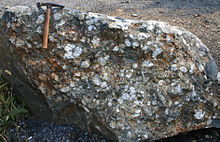Term: Conglomerate (geology)
**Classification of Conglomerates**:
– Named and classified by amount and type of matrix present.
– Classified by composition of gravel-size clasts they contain.
– Sorted based on size range of gravel-size clasts present.
– Method depends on type and detail of research being conducted.
– Named according to roundness of gravel.
**Conglomerate Texture**:
– Contains at least 30% of rounded to subangular clasts larger than 2mm in diameter.
– Space between clasts filled by a mixture of silt, sand, and clay known as matrix.
– Paraconglomerates have gravel clasts floating within the matrix.
– Orthoconglomerates are typically cross-bedded and well-cemented.
– Reflect differences in deposition: paraconglomerates often glacial tills or debris flow deposits, while orthoconglomerates are associated with aqueous currents.
**Clast Composition**:
– Classified by composition of clasts as monomict, oligomict, or polymict conglomerates.
– Source indicated by lithology of gravel-size clasts.
– Extraformational conglomerates have clasts significantly different from matrix.
– Intraformational conglomerates have clasts consistent with matrix lithology.
– Two types: shale-pebble and flat-pebble conglomerates.
**Sedimentary Environments**:
– Deposited in deepwater marine, shallow marine, fluvial, alluvial, and glacial environments.
– Turbidites in deepwater marine settings have well-sorted conglomerates.
– Basal conglomerates in shallow marine settings represent shoreline positions.
– Fluvial conglomerates are well rounded and poorly sorted.
– Fanglomerates in alluvial environments are associated with debris-flow deposition.
**Examples and Miscellaneous**:
– Various examples of conglomerates found on Earth and Mars.
– Metaconglomerate: Metamorphic alteration changes conglomerate into metaconglomerate.
– Related concepts: Puddingstone, Jasper conglomerate.
– References for further reading on sedimentology and stratigraphy.
Conglomerate (/kənˈɡlɒmərɪt/) is a clastic sedimentary rock that is composed of a substantial fraction of rounded to subangular gravel-size clasts. A conglomerate typically contains a matrix of finer-grained sediments, such as sand, silt, or clay, which fills the interstices between the clasts. The clasts and matrix are typically cemented by calcium carbonate, iron oxide, silica, or hardened clay.
| Sedimentary rock | |
 Boulder of conglomerate with cobble-sized clasts. Rock hammer for scale. |


Conglomerates form by the consolidation and lithification of gravel. They can be found in sedimentary rock sequences of all ages but probably make up less than 1 percent by weight of all sedimentary rocks. In terms of origin and depositional mechanisms, they are closely related to sandstones and exhibit many of the same types of sedimentary structures, e.g., tabular and trough cross-bedding and graded bedding.
Fanglomerates are poorly sorted, matrix-rich conglomerates that originated as debris flows on alluvial fans and likely contain the largest accumulations of gravel in the geologic record.
